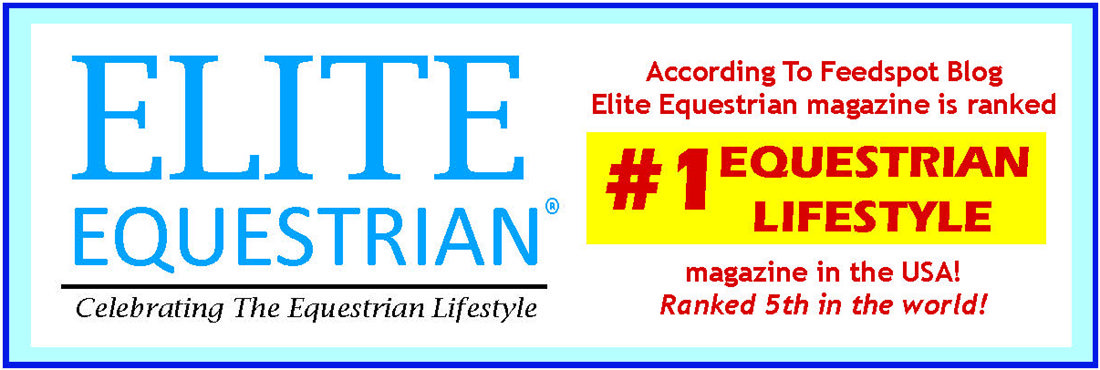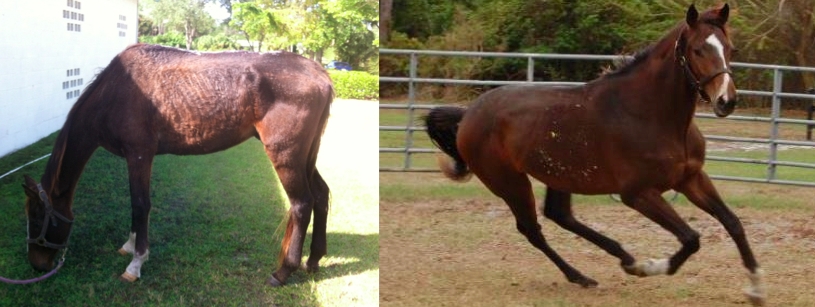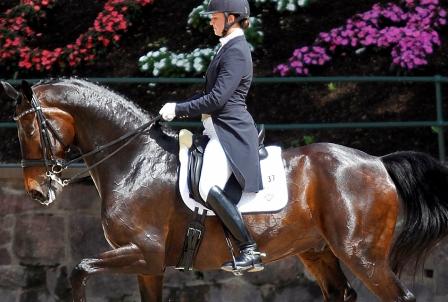
Its Not Just Tricks
By Sue De Laurentis and Allen Pogue Imagine A Horse 2010
Any specialized move that a horse learns such as a spin, slide, crossing a bridge, retrieving a Frisbee or taking a Bow can be considered a trick. Trick Training is not an end point but rather the beginning of an educational journey that can lead to the creation of a high school horse, trail horse, or a dependable, adaptable companion horse.
Imagine a Horse is dedicated to Enlightened Trick Training and our philosophy is inspired by Alois Podhajsky, a past director of the Spanish Riding School whose motto is, “The goal of all training is to make the horse more beautiful.” The horse naturally is a noble being and its beauty is enhanced by individual expression, inspiration, cooperation and willing obedience. Trick Horse Training not only encourages a horse to “learn how to learn” but it also promotes improvisation and certain aspects such as Liberty training, allow for generous latitude by the horse which magnifies his beauty and showcases his intelligence.
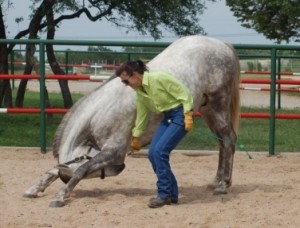
In Trick Training, we utilize lots of props including pedestals, big (herding) balls, bean bags to sit on, frisbees to retrieve and target boards. Horses can make powerful associations between objects (or props) and actions and when we add positive reinforcement including food treats, the results are extremely rapid. The horses love this type of education because it is easy for them to understand and its fun, not so much like work, but more like play. Most animal behaviorists agree that horses are the smartest of all domesticated animals and we believe that they are capable of much more than is ever asked of them. Trick Training can be a great way to maximize your horse’s personality and intelligence and desire to interact in a way that makes sense to him.
Knowing how to teach a few fundamental tricks could actually help to save your horse’s life or at least make medical treatment easier. In the book about Ruffian titled Burning from the Start, it is told how this famous race mare came to her untimely end because she was so hot and difficult to handle that successful treatment of a broken leg was impossible. What if Ruffian had been taught while still a foal to lie down and remain down quietly? Would it have taken away her desire to run and to win? We do not know the answer, but lying quietly would have allowed her to be treated when her life depended on it.
What makes a Trick Horse Candidate?
Our Missouri Fox Trotting Horses and Tennessee Walking Horses have great aptitudes and desire for Trick Training but horses of all breeds can be candidates. Trick Training comes easiest for the most personable, and energetic horses. A horse that has playful tendencies and a desire to interact with humans usually makes a great trick horse. Horses that seem dull or uninterested in human interaction may not be the first choice but many horses actually perk up considerably when introduced to trick training because it is so easy to understand and in turn easy for them to be successful. Horses that have a sense of humor make great candidates and so do Houdinis of the horse world that open gates or pick up objects to use as toys or to ask to be fed.
If you plan on teaching your horse tricks, preparation requires the same good manners and respect that would be required before beginning training for any other equine discipline. Teach your horse basic ground skills and work out areas of resistance before you begin. Trick Training is often a good vehicle to reduce a horse’s stress level because the steps and sequences are easy for the horse to understand.
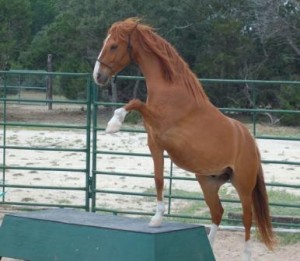
The props, equipment and preparation required are well worth the extra effort. In addition to the pedestals and equipment we already mentioned, we like Horse Friendly whips that we designed to convey a touch cue between horse and handler but don’t sting! Our large Horse-TUFF balls can be a great training aid to help to develop a horse’s herding instinct and sense of play. Leather tabs sewn to Flags and Frisbees make it easy for the horse to learn to pick up different objects.
A word of caution; while we use food treats as a motivational tool, some horses just can’t tolerate treats and maintain their good manners. A good resource for learning how to use food treats both effectively and responsibly is our DVD titled “Using Treats as a Training Tool”.
Pedestal Training
Did you know…All species of animals trained by humans (excluding horses!) are trained using a place or mark? Big cats, birds, reptiles, elephants, and dogs (canine agility), all benefit from training that uses a pedestal or mark. We believe that horses can benefit even more than other species with pedestal training because they are a flight animal. The pedestal gives a horse a piece of real estate that is his; a home base where he can take a break, and receive praise. Pedestal work helps to develop physical dexterity, increase self-confidence, boldness and a sense of security.
Tricks of Trust
Tricks of Trust include the Obeisance or Circus Bow, the Bow, Kneel and Lay Down. These are all moves in which a horse learns to lower his eye and his body to that of the handler which puts him in a position of mental and physical submission, and requires great trust in his handler. In this case, submission means that a horse is agreeable and willingly responds to our requests and acknowledges the human’s position as leader in his herd (of two). A simple example of submission is when a horse lowers his head willingly to allow the handler to place a halter or bridle.
Tricks of Engagement
In retrieving an object such as a frisbee, flag, or cap a horse willingly chooses to engage in the activity with his handler. This includes herding and retrieving the Big Ball. A horse cannot be forced to do these behaviors, but rather he chooses to do them and engage. Willing engagement is a giant step in creating a can do attitude that develops into a want to do work ethic.
Tricks of Agility
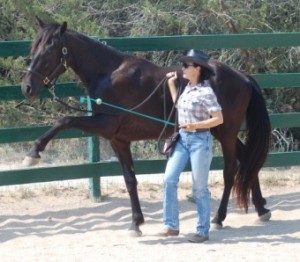
The Salute (Jambette), Crossing the Front Legs, the Rear, Hind Leg Walk, the Sit Up and Sit Down and gymnastic moves on pedestals including leaping from pedestal to pedestal are all good examples of Agility moves. We feel compelled to add that we teach the Rear only in association with a pedestal and we never encourage teaching it when mounted. By using the pedestal as a target for the Rear, the horse learns to move forward confidently. In other words he is relaxed and collected while moving forward rather than retreating and rearing in fear, as in traditional methods of teaching this move.
Tricks of Gait
Tricks of gait include amplifications of natural movement. The Spanish Walk, Circus March, the Three Step and the classical movements of Piaffe, Passage, Terre a Terre even the airs above the ground (Levade, Courbette and Mezair) are included. Yes, gaited horses can do the Spanish Walk!
Liberty Training
Liberty schooling is one horse or a troupe performing without any attachment (such as a lead or bridle) to the trainer. Liberty Training begins in a small square pen and the horse learns to walk with the handler, halt, make inside turns and circles and also to go to pedestals as directed.
Another variation of Liberty training is horses that each execute patterns solo, in pairs or in sets of pairs. A further variation would be horses that know numerous moves or elements of an act and then perform these in a routine as cued by the handler. Our (IAH) style of Liberty performances include numerous pedestals which are used to define the patterns and as a place for one or more horses to stay while others perform.
Where to Start?
There are several starting points mostly dictated by the personality traits of the individual horse. For a horse that is flighty, pedestal work will help him learn to be grounded, literally and figuratively. When a horse is lunged on a working length line and asked to mount the pedestal and stand quietly, the trick quickly becomes the reward rather than the work. Revolving pedestals and multi-tiered pedestals provide challenging variations and learning opportunities both mental and physical.
A horse that lacks respect or compliance can be helped to gain these virtues with tricks of trust as they require him to develop a submissive attitude. The Obeisance, Jamebette and the steps required to learn the Spanish Walk help to increase strength and range of motion in a horse’s front legs and shoulders which can be really helpful to gaited horses. With the Sit Down (on the bean bag), the horse uses every muscle in his top and also rotates his pelvis underneath his body. As with yoga for people, extreme poses yield extreme physical results! Herding the big ball is an activity that brings out a horse’s herding instinct and sense of play. Teaching a horse to retrieve will help to develop the handler’s training acumen. Liberty training can increase confidence and reliability in both the horse and the handler.
A person that is no longer able to ride or a person that is fearful of their horse can become energized with trick horse training as it can unveil a dimension of their horse’s personality that they may not have know even existed.
Note–We don’t teach party pony tricks such as counting or saying yes or no because they are ends to themselves and in addition, the horse is not is not really counting but waiting for a cue to stop pawing. In Enlightened Trick Training, each initial step is a building block in creating additional behaviors. A move such as the Jambette forms the basis for the Spanish Walk which is a classical move.
Trick Horse Training is a great way to have fun with your horse and for both of you to learn some really cool yet classical moves. We dare you to Imagine the Possibilities!
